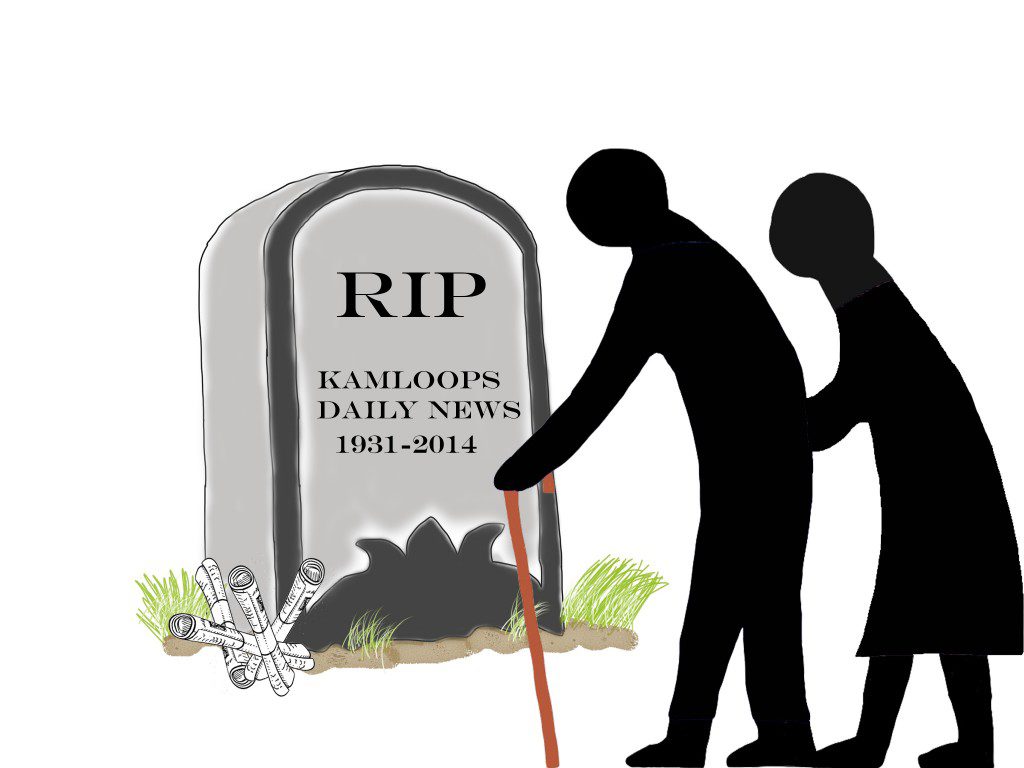Kamloops no longer has a daily paper, but it’s no town without news
When the Daily News shut down, it deprived residents of the B.C. city of their regular routine, but not of journalism
With a ceremonial click of a button, Mel Rothenburger, who’d retired as editor-in-chief in 2012, simultaneously put to bed the last issue of the Kamloops Daily News and an 80-year-old tradition. The front page headline on the January 11 edition read, “I really don’t know what I’m going to do when there’s no paper.” The closure left Kamloops, a city of nearly 90,000 people, without a daily newspaper. Reporter Michele Young had not yet cried during the rough week but nearly broke down when she saw one of her colleague’s watery eyes.
Earlier that week, publishers Tim Shoults and Peter Kvarnstrom of Glacier Media gathered the team of 55 employees to give them the bad news. They chalked it up to economics in the industry. Despite having built up a thriving website, paid circulation numbers were dwindling and there wasn’t enough revenue. Even with two months’ notice, the team stopped publishing within five days. As Young says, “It’s not like anybody had any heart left.”
Shutting down the paper ended many of its employees’ careers in journalism—and a treasured ritual for the reader. But reactions to that loss seem to say more about a generation gap than the need to be informed. One year later, with easy access to journalism online and from broadcasters, many in the town are finding that a daily paper may be more about the habit than the news.

By Aimee O’Connor
Since it started as the Kamloops Shopper in 1931, the newspaper was something people could count on every day. Although its paid subscribers had dipped to about 10,000 by 2011, the Daily News was still highly regarded in the community for its award-winning news coverage and philanthropic efforts. In 2013, three reporters earned nominations for the National Newspaper Awards for a series criticizing the state of rural health care and a historical feature detailing the murder of three police officers 50 years earlier. And Rothenburger, who was at the paper for over 40 years, won a Jack Webster Foundation lifetime achievement award in 2011. Meanwhile, the Daily News raised money and gave ad space during its notable Raise a Reader and Christmas Cheer Fund campaigns.
The same day the Daily News made its announcement, the biweekly community newspaper Kamloops This Week revealed it would return to printing three times a week. As a free paper, KTW is a different breed of publication. Still, readers expected it to beef up its reporting and take over where the daily left off. Ten months later the staff has increased slightly, including three from its old rival and several recent journalism graduates. Former Daily News city editor Susan Duncan says that while KTW covers crime and politics, it misses stories on the environment and school board. She says it also lacks the continuity that her paper provided. “We could take a local issue and report continuously on it and provide commentary in columns and opinions.”
But the community has other options with five radio stations, including a CBC bureau established in 2012. There are also weekday television newscasts by CFJC-TV. And Rothenburger, who once served a term as mayor, started a news blog called “The Armchair Mayor.” Initially a place for commentary on the closing of the Daily News, the blog now has community news and guest columnists written by former colleagues. Since he’s retired, Rothenburger has time to keep up the blog, posting every few days with short news articles and more thought-provoking opinion pieces.
The importance of having a daily goes beyond the luxury of getting news delivered to your door. Brian Legree was a sports editor at the Oshawa Times in 1994 when Thomson Newspapers closed the long-standing paper after a three-week strike. At the time, the daily was a fast-acting and reliable news source. The Times closed down when papers had only just started migrating online and few readers looked to the internet for news. So, explains Legree, people worried about losing what newspapers should fundamentally do—keep an eye on institutions and government. “People looked at the Toronto Sun, which rose from the ashes of the Toronto Telegram, and wondered if that could happen here,” Legree says. “Ultimately, it did not.”
Although the Sun and the Toronto Star both publish news from Oshawa, a daily newspaper becomes part of a community’s fabric: who its citizens are and what they stand for. Now a journalism professor at Oshawa’s Durham College, Legree says this connection stems from citizens identifying with a paper product.
Nearly 20 percent of Kamloops residents are aged 65 and older, part of the generation that grew up with newspapers. In part, the daily paper becomes what Legree calls their “news buddy.” So losing it becomes less about the news and more about the ritual of collecting a paper every morning to mull over with a cup of coffee.
When that demographic “goes to their maker,” KTW editor Christopher Foulds hopes to have the right product for the next generation. The paper’s strength is its online presence. So while some readers in Kamloops still complain that they miss their beloved Daily News, there’s news one click away that wasn’t readily available when the Oshawa Times closed.
With other options, the community isn’t starving for news. “The problem is we don’t have a daily paper,” says Charles Hays, an assistant professor of journalism at Thompson Rivers University in Kamloops. That not only eliminates people’s morning reading routine, but also the social aspect—people’s conversations about what they read. “I’m not convinced that simply having a dead tree with ink smeared on it delivered to my doorstep is the only reason to keep a newspaper open.”





![[Redacted]](../wp-content/uploads/2014/12/Screen-Shot-2014-12-03-at-11.13.02-AM-150x150.png)










I’d like to point out that the closure of the Kamloops Daily News wasn’t just the death of another newspaper, but also a huge loss in terms of continuity of information as well as the death of the biggest online news provider in Kamloops. That seems to be forgotten in the stories that are focussed on the physical paper, and ignoring the fact that the KDN’s online presence was bigger and better than any other in town.
News was posted immediately, coverage went from early morning to late at night, the number of hits/page views on our web site was higher than any other news company in town (and probably second highest in the Glacier chain, assuming the Victoria Times-Colonist was tops) and we had a vibrant (albeit sometimes over exuberant) commenting community.
So it wasn’t just the loss of a paper. It was the loss of two media outlets, really.
A few other corrections. The KDN’s circulation in 2013, as I heard it, was 12,000. We won a National Newspaper Award in 2013 (out of two nominations) and we had two nominations for Jack Webster Awards in 2013 (we lost both but we were up against big-budget, big-staff outlets like the Vancouver Sun and CBC national). We had a long list of other wins in previous years.
Now those journalists are becoming plumbers, job developers, real estate agents and one web strategist. Most of us want to remain here, and that means limited options. I’m training to be a pharmacy technician after 30 years in journalism because there are more pharmacies than media outlets in Kamloops. And local media aren’t hiring those of us with experience; some of them have undergone cutbacks. (Kamloops This Week took two reporters; a third they hired quit after four days. They have since hired two recent j-school grads, not several as this story says.)
Kamloops is poorer for the lack of depth and continuity that comes from daily newspaper reporting. It’s poorer for the online presence that the KDN had. And while a new online company just launched this week, its stories are only a few paragraphs and its staffing is small.
One other point. For those who live in B.C., Glacier Media and Black Press just ‘bought’ (or swapped) many of their newspapers in competing communities on the West Coast and Vancouver Island. That means in many communities, the same company now owns both newspapers, instead of there being competing newspapers. From a strict business model, that won’t make sense to keep two entities going in one community. I expect there will be a lot more layoffs and closures soon to come (I went through a similar experience 20 years ago in Brandon, Man.)
It isn’t just about Kamloops and it isn’t just the loss of newspapers. And once they’re gone, they don’t come back.
It is hard to find the nut graf in this story but unless it is buried elsewhere, it seems to be this at the end of paragraph three: “One year later, with easy access to journalism online and from broadcasters, many in the town are finding that a daily paper may be more about the habit than the news.”
How did the writer conclude that “many” people in town agree with her opinion that easy access online replaces a daily newspaper and that reading a newspaper was a habit, presumably meaning an empty habit? And how many is many?
To understand the loss of information with the demise of the Kamloops Daily News, you have to consider the number of reporters producing stories in its newsroom, the number of stories being produced and the depth of the stories, compared to the same elements in any particular other competitor.
The number of other media outlets added up is not a reliable factor in the comparison. The number of other outlets online or broadcasting does not mean more information in itself, because they may be repeating the same story. A number of outlets producing the same story and the ease of access can create the illusion that there is a plethora of information.
If the role of the media is to create soothing and satisfying illusions, then maybe we should not worry about the death of an apparently obsolete “habit.”
Otherwise, the media that are surviving in these volatile times need to pick up their game, which some are indeed doing in interesting and commendable ways.
Please excuse the grumpiness of someone from the “generation gap” who worked at a daily newspaper in the distant misty past.
You are aware KTW was named the best community newspaper in the country last year by the CCNA, right? And won several other editorial awards last year and in years previous, including Webster’s. And you are aware there is a newsroom of 10 staff, some with little experience and some, like me, with more than 40 years of experience — more than 25 years of that at the London Free Press. So I would hasten to suggest that your portrayal of our newspaper and our newsroom is lacking completely in any accuracy. And I’m sure you’re also aware, but just failed to mention, that KTW took on many of the community activities the Daily did so well, including the Christmas Cheer program, which raised, in our first year, almost $50,000. Since you do not live in Kamloops, you have no way of knowing KTW has a beat reporter who covers education. If you do a search of our website, you’ll find dozens of education stories. Yes, it is sad that the Daily closed down. Yes, even those of us at KTW miss reading it but to say Kamloops is lacking in a newspaper belittles the work of the young journalists who work with us and who are dedicated to what many believe is a dying industry and it simply ignores the quality of work all of us produce every single day.
The spirited responses of Dale Bass and Michelle Young show a pride in the accomplishments of the reporting staff of their newspapers and a healthy competitiveness. Both newspapers are commendable. The demise of either newspaper is a loss to the community. And it is sad to see so many long-term journalists losing a job they loved. For me, that is a personal flashback to the moment that one third of the news staff were fired in the daily newspaper where I worked in the mid-1990s. The local TV station here in Kamloops did a wonderful job recently in a broadcast piece on the anniversary of the end of the Kamloops Daily News. That broadcast piece was sincere and genuine in recognizing the loss to the community, which was a generous act from a competitor even to remind its audience that the daily newspaper was gone. If some day Kamloops This Week were to suffer the same fate as the Kamloops Daily News and go to its maker, it would not be another instance of an obsolete reading habit disappearing that can easily be filled by the remaining media. That is the real point. As the number of reporters shrinks in different communities, is there still the same quality and quantity of reporting?
Pingback: A town without a daily — less about news, more about ritual – The Armchair Mayor News
The fact the editor-in-chief of the paper became the city’s mayor speaks to how influential KDN was. I grew up reading it every morning and I think it was a big reason I went into journalism.
It’s a sad story – one that’s becoming more and more common in this country. The small city dailies are being gutted more than any other publications and more are going to disappear.